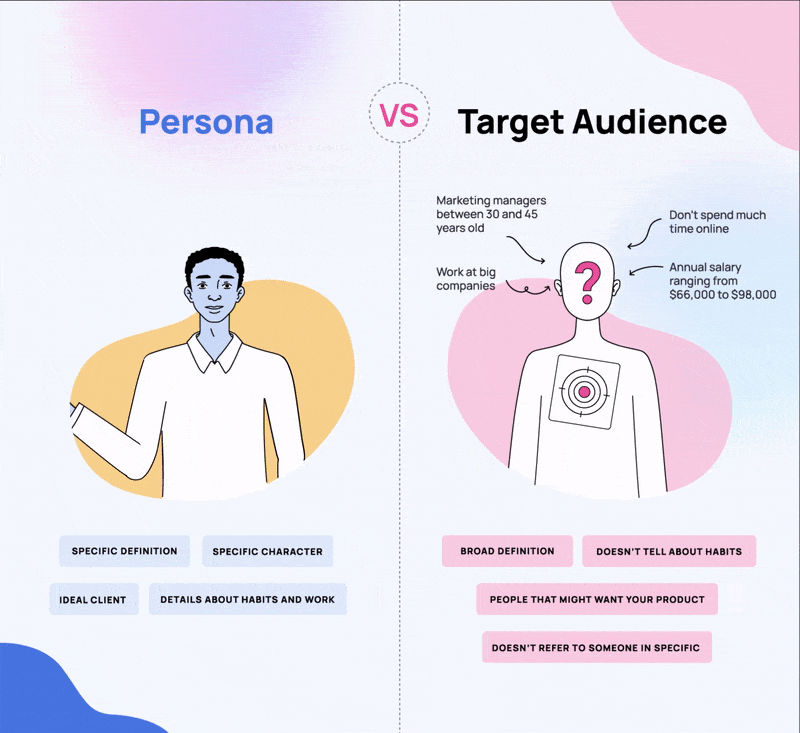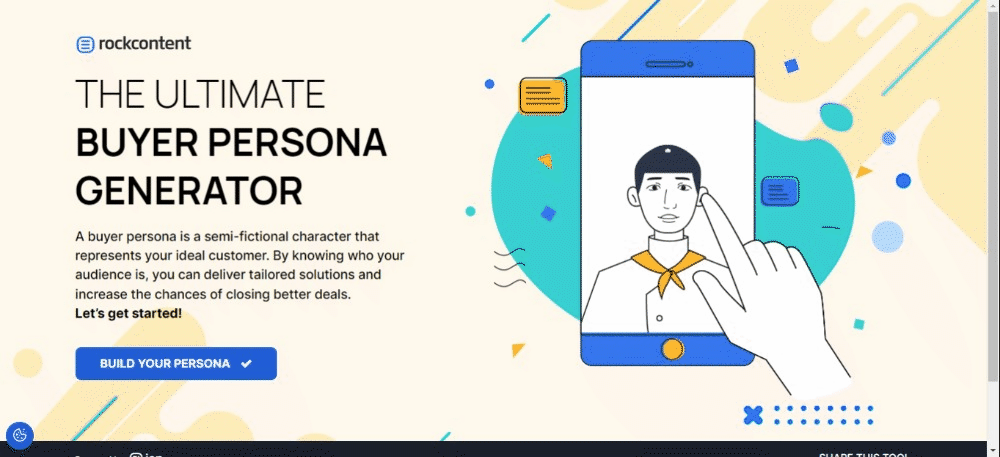If you have a business, you certainly want to obtain more leads and increase your revenue, right?
To accomplish this, it is necessary to create and execute a marketing strategy, which includes content production and other actions, as a way to prospect consumers.
It works like a conversation, allowing you and your audience to build a relationship.
However, will your strategy ever work if you try to talk to everyone?
No, because if you decide to speak to everyone, nobody will hear you. The reason for that is simple: people have different needs, opinions, pain points, and challenges. So, if you want their attention, they should see that you understand their particularities and want to help them.
To achieve this objective, and accurately reach your audience, you should start by building a buyer persona, also known as a persona. Creating it is the basis of a Digital Marketing strategy.
This content will cover the following topics:
Download this post by entering your email below
What Is a Buyer Persona?
A buyer persona is a semi-fictional character that represents your ideal customer.
Creating it requires careful work that includes market research, customer data that you already have, and even some assumptions.
Check out this animated infographic to get a clear picture of what we are going to discuss in this article:

Once you build your persona’s profile and describe its characteristics in detail, you will be able to address your Marketing efforts to the right people.
After all, if you know your ideal customer “in person”, it is easier to talk to them about things they are interested in.
The concept of buyer persona was created by Alan Cooper, a software designer, and programmer. It became popular with Inbound Marketing.
Nowadays, it is helping businesses and marketers all over the world to reach customers, establish a relationship with them, and make more sales.
Now that you know the theory, how about understanding the concept of persona in practice?
First of all, imagine a company that offers CRM software. How would its persona look? Let’s see the following topic.
Buyer Persona Examples
First, we would like to recommend you take advantage of the Buyer Persona Generator from Rock Content. Use your creativity and try to connect the personas to your business.

William, 35 years old, married, has a bachelor’s degree in Marketing and a busy professional routine, although he tries to find a balance between work and family.
He works as a Marketing Manager for a company that supplies kitchen equipment to restaurants.
Pain points
Since the company’s early days, he has been working with spreadsheets to keep track of its customer base, which is growing fast.
Thus, he realizes that an old method is no longer an efficient tool, and the members of his team are complaining about their difficulties in using spreadsheets.
For this reason, he has been talking to the CEO about the possibility of acquiring a CRM system.
However, his boss thinks that spreadsheets are still an effective method of tracking sales and keeping a good relationship with customers.
Communication
William frequently searches CRM-related terms on Google, aiming to find the ideal solution for their problem.
He even asks for more information when he finds a system that he likes, and also wants to complete his benchmark by email.
He is on LinkedIn, where he regularly consumes content to keep up with his area, as well as on Facebook, which he uses for personal purposes. Also, Willian likes to watch the news on YouTube.

Solution
Because their business involves a lot of transactions and communications with customers, as well as orders with special requests, they need a CRM system with some specific characteristics.
For example, it must be easy to use and intuitive. Besides, it should be scalable, since the company will keep on growing.
Also, the software has to integrate with their email solution so that they can automate communication with leads and customers.
Finally, it must offer segmentation features, which will facilitate the Marketing and Sales departments’ work.
Below, you can find another three examples of buyer personas. They’re more concise than the one presented above and suggest a slightly different structure, also valuable.
1. Martin Mann
Target Product Line: Household Appliances and Equipment
- Martin’s Details ‒ Martin is a working dad with two children, ages 8 and 3. He is 36 and lives with his wife Paula in Georgia. They have a combined household income of $100,000. The family rents a home in the suburbs.
- Martin’s Pain Point ‒ As a busy dad, Martin is looking for products to help him squeeze as much time out of his day as possible. He wants to spend more time interacting with his kids, but he also has a household to keep up with.
- Martin’s Objections ‒ Even with a decent household income, money is always tight because of high bills. He wants affordable products that won’t put him into debt.
- Martin’s Goals ‒ He wants to be able to take care of household chores as easily as possible and spend more time with his kids.
- Potential Sales Pitch ‒ Cooking products that allow Martin to prepare meals faster and more efficiently. Also, cleaning tools to help with children’s toys and household items.

2. Samantha Grey
Target Product Line: Outdoor Equipment
- Samantha’s Details ‒ Samantha is a working professional who is single but actively dating. She is 28 and lives in an apartment in Los Angeles. She makes $85,000 a year.
- Samantha’s Pain Point ‒ She loves to go hiking and exploring, but it’s tough to plan a trip to the mountains. She wants to have convenient outdoor gear, so she can go whenever the opportunity arises.
- Samantha’s Objections ‒ She doesn’t want gear that is too heavy or takes up too much room in her bag. She also doesn’t want to waste money on cheap products that won’t last.
- Samantha’s Goals ‒ To spend more time outdoors hiking, biking, and exploring more of the natural wilderness. She has a few dream hikes she’s planning for the future.
- Potential Sales Pitch ‒ Hiking boots and clothes that are low-maintenance and built to last. Also, outdoor equipment can come in handy for her long-distance dream hikes (i.e., backpack, mini camp stove, etc.).

3. Jennifer Jewel
Target Product Line: Fashion and Accessories
- Jennifer’s Details ‒ Jennifer is a manager at a tech firm, and she’s actively dating and looking for the right guy. She is 31 and rents an apartment in a swanky part of New York. She makes $180,000 per year.
- Jennifer’s Pain Points ‒ She likes looking her best when she goes out on the town, but she can’t afford luxury prices at the moment. She doesn’t want cheap-looking products, either.
- Jennifer’s Objections ‒ If a piece looks too chintzy or cheap, she won’t want it. She also wants items that she can resell on consignment to fund her next batch of clothes.
- Jennifer’s Goals ‒ She wants to make enough money to have the wardrobe of her dreams, and she wants to travel more with a special person.
- Potential Sales Pitch ‒ Trendy accessories that can accentuate haute couture outfits. Clothing that is both functional and chic, and will last long enough for Jennifer to resell it at a decent price. Travel accessories and clothing may also be a good fit.

What Are The Types of Buyer Personas?
This could be a tricky question. If you look for off-the-shelf persona models to implement in your strategy, you may miss most of the benefits we have covered in this text.
This is because, as you know, each business has its particularities that must be considered when defining the objectives. Therefore, they must also be taken into account when developing the buyer persona.
In other words, do not look for ready-to-use personas. Instead, build your own based on the specifics of your audience and of your business.
Having said that, there is a way to categorize buyer personas. First, you should know that there is a big difference between B2B and B2C customers, so personas for these two business modalities have some details that differentiate them.
B2C personas
If you are in the B2C market, you are dealing with the final buyer of a product or service. In other words, your consumer wants to satisfy their own needs and desires.
B2B personas
B2B transactions involve buyers who not only have individual characteristics but also carry the needs and conditions of the companies that employ them.
In this way, B2B personas might be considered a bit more complex. They blend the particularities of the types of businesses that might be interested in your solutions with the individual traits of the people responsible for closing deals.
What Is a “Negative” Buyer Persona?
A buyer persona is designed to be a depiction of what you believe your ideal customer looks like. A negative buyer persona, on the other hand, is a representation of what you do not want your ideal customer to be.
For instance, a negative buyer persona may include people who are within a lower income bracket and are unlikely to afford your product. It may also include prospective customers who are simply too expensive to acquire.
More often than not, the information needed to create these negative personas will be found within your customer service and sales departments. You want to hone in on the traits of customers who had high acquisition costs, took a long to close, were just simply challenging, etc.
By creating negative buyer personas along with your regular buyer personas, you can better understand and identify those who are and are not a good fit for your service or product. You can fine-tune your marketing messaging and strategies to bring in a higher number of qualified leads.
Now, when it comes to the negative buyer persona, make sure to create it last. You want to focus on your ideal customers first, and then you can turn your focus to creating a profile for potentially problematic customers.
In the end, negative buyer personas will save you both time and money by not focusing on prospects who aren’t a good fit.
Target Audience vs Buyer Persona: What’s the Difference
I know we’ve already mentioned it here, but are you truly familiar with the concept of a target audience? It is important to know the differences between it and the idea of a persona.
Firstly, a target audience includes more general data, that is, demographic information of people that are more likely to become your customers.
A target audience profile can also include socioeconomic and behavioral aspects, although not as detailed as the persona’s characteristics. It has been widely used in offline marketing campaigns.
Some target audience examples to help you understand the concept:
- Marketing managers, 35 to 45 years old, working in companies in the state of New York;
- Men and women, 30 to 40 years old, middle class, owning dogs;
- Women, 25 to 35 years old, middle class, interested in DIY (do it yourself).
As you can see, a persona’s profile gathers much more information about the people you want to reach. But why is it so important?
9 Benefits of Creating Buyer Personas
Because they have such an impact on the Marketing department, it is natural that buyer personas benefit the business as a whole.
Of course, more efficient Marketing strategies expand the company’s reach and enable it to attract more customers, which consequently results in profits. But the introduction of a persona in your strategies brings advantages that go beyond the fulfillment of commercial goals.
1. Higher ROI
The idea behind creating a buyer persona is to facilitate the segmentation of the public so that the brand directs its Marketing and communication efforts to people who have a real possibility of becoming customers.
This means not only an increase in profits from sales but also an even greater growth in your ROI.
This effect is a result of the increased efficiency of the actions directed toward your audience. The persona serves as a guide to make these efforts in the most accurate way possible, avoiding spending time and resources unnecessarily.
If your ideal client is not a Facebook user, for example, there is no reason to allocate employees to produce content for this particular network. That way, you can find more effective means of investment.
You can also fit the persona into a paid ads strategy. As you know, tools like Google Ads and Facebook Ads allow you to target your campaigns to specific audiences, which you can customize according to interests and demographic factors.
Thus, if your business takes the buyer persona’s characteristics as the basis, you will ensure campaigns with much higher ROI levels.
2. Greater market authority
A company that can impact the right audience tends to grow quickly, gaining market share.
The persona helps you communicate more effectively with your potential consumers, conveying your brand’s values and visions through a solid, consistent approach.
The natural consequence is that people will start talking about your business, generating what we know as Word of Mouth Marketing.
In the age of consumer 4.0, this generates immeasurable benefits for the company. If your message impacted your persona, they will mention your brand positively in forums, social media, and other communication channels.
Today’s audience places a lot of importance on recommendations from other people, and they tend to share these recommendations with others. This creates a cascade effect that helps consolidate your company as an authority in the market.
3. Generation of brand advocates
Brand advocates are customers who grow so loyal to a brand that they become its staunchest advocates.
Not only do they fill social media with positive comments and share your content, but they also form a loyal buyer base. No matter what happens: they will continue to consume your products.
Great, isn’t it? But creating these advocates is a huge challenge for any company.
The Buyer Persona works as a facilitating tool in this process. By relying on the semi-fictional character to create content, develop products, and position itself with contemporary issues, the company can address its main pain points, needs, desires, etc.
In this way, you create a bond that goes beyond the customer-brand relationship, paving the way for high loyalty levels.
4. Improved communication with the public
The persona serves not only to guide the communication efforts made by the marketing team but by the entire company.
This involves, for example, customer service. This is one of the most critical points of interaction with the public, since it is usually the channel where customers go to make complaints and solve doubts.
Therefore, it is necessary to intelligently define the approach that will be used in this medium, including issues such as tone of voice and recommended expressions.
For this reason, we recommend creating a style guide that covers all areas of the company and clearly defines how employees should behave while interacting with people.
This guide should be based on the persona’s main characteristics, just like in a Content Marketing strategy. With positive interactions, you pave the way for a more long-lasting relationship.
5. Enablement of Smarketing strategy
The processes that involve the attraction, qualification, and conversion of leads become much more effective if they involve the Marketing and Sales departments working together.
The alignment of these two sectors is what we call a Smarketing strategy.
This approach aims to exchange insights between salespeople and marketers, facilitating the creation of experiences and triggers capable of moving the lead along the sales funnel and enabling its conversion into a client.
The structuring of a persona is fundamental in this process since it allows members of all teams, both in Marketing and Sales, to have the same ideal customer as their primary reference.
This way, in addition to maintaining constant communication and pursuing the same goals, both departments can create more accurate strategies to achieve their objectives.
6. A better understanding of your customer
Imagine you’ve just met a person and you want to establish a pleasant conversation. Maybe you agree that you will be more likely to accomplish that if both of you share common interests, right?
So, as the person talks about their interests, goals, and challenges, you can tell them your opinion and even offer suggestions.
In the relationship between your business and your customer, the same occurs. Once you have a complete profile of your ideal client, you will be more likely to be empathetic, and your prospect will feel you understand and want to help.
7. Higher efficiency
Directing your Marketing efforts toward a persona will help to save time and money. You will have a higher chance of reaching people who have the exact problems your product or service is meant to solve.
Thus, with less time and money spent, the cost of attracting each customer is lower.
8. Accurate segmentation
If you have a buyer persona, you can segment your communication according to people’s preferences. Think, for example, about the language you should use.
Do your prospects like to talk formally or informally? What vocabulary do they use? Do they prefer reading a text with technical terms? Would they like it if you use emojis?
Segmentation also includes appropriate content, according to the customer journey stage that your lead is in.
For example, if the person is at the awareness stage, he needs more educative and general content, which is present in blog posts and infographics. At the decision stage, interactive calculators and case studies would be welcome.
When you have a buyer persona, you can answer all these questions. Thereby, you will help your customers to move through the customer journey, which will increase the number of sales and, of course, revenue.
9. More persuasive approach
Because objections are a natural element of a negotiation, you must be prepared to clear up your prospects’ doubts.
However, if you have a persona in mind, it is also possible to predict issues that may come up and cover them, for example, in blog posts, ebooks, and case studies.
Besides that, you will be able to clear up possible questions in the content of your emails, so your approach will be more persuasive. If you do so, your email marketing strategy will be more effective.
Localization and International Buyer Personas
If you’re running a business with customers around the world, you must take an even more careful approach to creating buyer personas. While the broad details may be similar across borders and continents, there are a few other factors to consider when developing international customer profiles.
Search trending keywords
People may search for products and services with different keywords in their home country. What you can do is use Google with an anonymous browser window and the country’s extension code. For example, in the UK, the code is .uk, and in Chile, the code is .cl.
Searching for trending keywords in each country will help you identify how people search in the region, which can give you insight into their thought processes. Also, you may discover that some topics or products are trending much higher in one country than another.
Look at competitors
The top brands in a country can tell you a lot about how people shop and browse products in that country. So, doing some competitor research can tell you what’s working and what isn’t. While you don’t want to copy any of your competitors directly, you can pay attention to elements like:
- Color Schemes ‒ What colors are used for logos and ads within your industry? Colors can have different local connotations, sometimes by association with a particular brand or product.
- Copy ‒ What kind of slogans and copywriting do local competitors use? Are there turns of phrase that locals understand that would be lost on a different audience? Does the copy change from one region to another (i.e., North India vs. South India)? Also, keep in mind that direct translations are often incorrect. Instead, it’s better to have a native speaker translate ads to catch any nuances or context clues.
- Imagery ‒ What images or graphics are used in advertisements and content pieces in your target region? Do companies rely on photos or illustrations more? What about the typography?
Conduct audience research
Finally, the best way to develop a buyer persona is to speak with individuals from the region. You can do this via surveys or questionnaires, but make sure to incentivize respondents so you can get as much feedback as possible.
In addition to surveys, A/B testing can help you refine your messaging and landing page layouts to see what elements attract the most attention.

The 2 Most Common Questions When Creating a Persona
Let’s get to it:
1. Do small businesses need a buyer persona?
It is easy to understand how this tool can help giant companies with large numbers of employees and customers. But is it suitable for smaller clients? The emphatic answer is yes.
Regardless of your business size, the use of a buyer persona is essential for reaching your goals.
Even a self-employed dog walker needs to better understand their audience if the goal is to extend their customer base and increase their revenue.
2. How many personas should be created?
Should I create only one? Can I create as many as I want?
At this point, it is necessary to act according to your reality. If you sell products/services to audiences or markets with different characteristics, it makes a lot of sense to create more than one persona, so you don’t need to limit it to one.
However, it is essential not to exaggerate. Working with too many different personas can lead to confusion in your communication strategy and weaken your messages.
With this in mind, you can work out the ideal number for your company.
What Are The 5 Main Errors When Creating A Buyer Persona?
You already know the main steps to creating effective buyer personas. Now, it’s time to understand some of the worst mistakes companies make in this process. This way, you can prevent them and ensure better results for your strategies.
1. Using too many assumptions
Buyer personas are semi-fictional characters. This means that you should not develop them based on assumptions but rather through serious behavioral research and data analysis.
To get relevant information for creating your persona, it is essential to conduct interviews with real people. We will talk more about this later.
2. Overusing demographic information
Using demographic information is undeniably vital for building a buyer persona. However, you should not pay too much attention to this factor.
Your persona should get as close as possible to your potential customers’ real conditions, highlighting their pains, desires, needs, dreams, hobbies, and many other elements that cannot be captured purely by demographic research.
3. Interviewing the wrong people
When setting up interviews to collect data for your persona, it is essential to properly define the people that will participate in the process.
You know that the goal is to find your ideal customer, but who exactly is that? You need to think about this question and define, first of all, to whom your company wants to sell its products and services.
When defining the interview list, many companies stick to the customers they already have. Although they are important in the process, limiting yourself to interviewing current clients result in inferior buyer personas.
4. Having Too Many Personas
There is no one-size-fits-all number when it comes to the number of buyer personas you should create. There are several factors that contribute to the number of personas you need. These may include the different industries you serve and the number of offerings you have available.
However, creating too many personas, especially in the beginning, can overwhelm you and be incredibly distracting. Further, a high number of buyer personas will divide your marketing efforts, keeping you from focusing on the necessary actions to drive optimal results.
This is especially true if there is any overlapping between the profiles. After all, each buyer persona should be unique to ensure your message is vastly different and tailored to that specific persona. You need to be able to create content that will resonate with potential customers and not confuse them.
Ideally, you should start with no more than three different buyer personas. These should focus on the ideal customer segment that provides the greatest opportunities and value for your business moving forward.
New buyer personas can be added at a later date if you want to expand into a new market or target a new audience when your product offerings grow.
5. Making Profiles Based Just on Stereotypes
When profiling your target audience, it can be easy to rely on various forms of stereotypes. If you allow bias to enter your buyer persona profiles, you will not be creating a realistic image of who your ideal customer is.
Instead, when stereotypes and personal bias enter the process, your personas will be reflecting the desires and wishes of the company. The use of real data can help reduce the risk of bias being injected into your buyer personas.
How Does a Persona Affect Your Content Production?
When you have a persona and know your prospects and customers, you can understand the purchasing process.
This knowledge will affect your content production because people need different types of content as they go through the stages of the customer journey.
Awareness stage
Think about a person who has just found your blog. To solve a problem, they probably searched a keyword on Google and found you.
Because he is at the awareness stage, he will need educative and more general content, which he will find in blog posts, infographics, and videos.
Evaluation stage
As the prospect goes to the evaluation stage, you should offer, for example, ebooks, webinars, whitepapers, and newsletters, among others.
Decision stage
Finally, the person gets to the decision stage, where they need to make a decision: to buy or not.
To help them make the best decision, there are some appropriate types of content, such as case studies, free trials, discount coupons, and even a chat with a consultant.
You can see that the type of content depends on the customer journey stage the person is at. If you build your persona properly, your content strategy will be more effective, and you will be more empathetic and engaging.
What is The Relationship Between The Buyer Persona And The Buyer’s Journey?
Just like the persona, the buyer’s journey is a very widespread and relevant concept in the Digital Marketing field.
Both ideas are interrelated within any mature strategy since they have to do with the efforts to approach leads in the best possible way.
Thus, the buyer persona establishes who to approach, while the buyer’s journey indicates when to approach them.
It is vital to understand how the two tools are intertwined. If you have a strong buyer persona, you can map out effective ways to influence their buyer’s journey.
In turn, this journey needs to be closely monitored to ensure that the lead has access to the right content at the right time.
If a lead is still in the awareness phase and receives content from the bottom of the funnel, for example, the whole strategy may lose its effectiveness.
How To Create Great Content For Your Persona?
Once you have established your persona(s), it’s time to create impactful content that resonates with them.
The first step is to define the channels where such materials will be available. The ideal is to be present on all networks where your persona has the habit of browsing, as well as establish a blog to centralize your content and increase your digital authority.
Although every channel is essential, in some cases, it is necessary to focus on just a few.
If your persona is a young adult, for example, she’s probably not a Facebook heavy-user. In this case, producing content for Instagram and YouTube would make a lot more sense.
In addition, you need to define the content format. Some people are more attracted to videos than text. Others prefer reading an article while commuting to watching a webinar. It is essential to understand these particularities to improve your approach constantly.
In the bigger picture, we can say that creating great content depends on identifying trends that appeal to your persona and offering unique experiences.
You can accomplish this through Interactive Content, which generates about 88% more engagement than static content. This is a trend in the content sector and will help you capture and retain your ideal customer’s attention.
You can also count on content creation platforms like WriterAccess and connect to thousands of freelance writers, editors, strategists and proofreaders that can craft the ideal content for your persona.
How To Create a Buyer Persona In 4 Steps!
As we already said, to create a buyer persona, we can’t rely on assumptions alone. Some inferences may indeed be necessary, but most of the work depends on surveys, which can be done using interviews or forms.
If you ask the right questions, you will be able to gather all the information you need to build an accurate buyer persona. Let’s take a look at some steps that you need to take.
1. Collect data
What would be the best source of information to create a profile of your ideal customer?
Your customer base, of course.
In fact, you can interview not only people that have already purchased your solution but also your prospects. So let’s discover some methods for collecting data.
Researches
You can analyze your customer base to discover trends regarding how they consume content.
Besides that, landing page forms can be used to collect useful information. Interactive quizzes are a great way to do that because they are attractive, engaging, and even fun.
Talking to experts can be helpful too because they have a better understanding of your audience.
So, ask the sales team, trainers, tech support, and writers who write copy for your audience, among others, for information about the people you want to reach.
Besides that, Google Analytics and competitive analysis can offer you useful information about people who could become your customers.
Surveys and interviews
It is essential to have in mind that customers have different levels of engagement. Depending on the size of the form, some of them may not be so interested in helping you.
On the other hand, a small form or interview will not supply you with the necessary information.
Create smart questions, which may be arranged into four categories: demographics, personal data, content consumption, and challenges. Take a look at the following examples.
Demographics:
- What are your gender, age, and education?
- Where do you live?
- What do you do at work? What is your job position?
- What is your company’s industry?
- What is the size of your company?
Personal data:
- What are your goals?
- How is your routine?
- What are your responsibilities?
- What challenges do you have at work?
- What does success in work mean to you?
Content consumption:
- What social networks do you use?
- What subjects are you interested in?
- What content formats do you like?
- Where do you find information that is useful to your work?
- How do you learn and acquire new skills?
Challenges:
- What challenges did you have before finding us?
- How are we helping you solve problems?
- What characteristics of ours do you like the most?
Who to interview?
You may be wondering about who exactly to interview. Well, you may get tempted to talk only with “good” customers, that is, people who love your business and its solutions.
However, “bad” customers, who are not so satisfied with your service or product, can offer valuable information. Indeed, interviewing them could even help you to improve your solution.
You can also interview people who have not yet purchased your solution, especially if your business has just started, and you still don’t have a customer base.
How many people to interview?
There is no definitive answer to that.
However, as you do interviews, at some point, you will start to predict the responses of interviewees. You will notice patterns, so if you start to precisely predict what the person will say, you may stop and go to the next step.
2. Analyze the collected data
Now that the interviews are done, you have a lot of information to analyze and arrange.
How exactly could you do that? Search for common characteristics among interviewees, and what problems and challenges were mentioned the most. Thus, you will understand what type of content could be more relevant to them.
After, you need to decide how many personas your business will have. Is it possible to gather the information for only one persona? Or would it take the creation of more profiles, maybe two, three, or more?
Regardless of the number of personas, remember that your Marketing strategy should include all of them. So, there must be blog posts, ebooks, and nurturing flows, among others, for each persona, ok?
3. Build the persona
Now, turn all the selected information into a person. Open your text editor and build a profile with name, age, and occupation.
Besides writing about their day-to-day life, you can even create a quote, relying on the interviews of course, as if the persona itself was telling you about their challenges and goals.
Next, arrange the information according to topics such as personal and professional goals, as well as pain points and challenges.
After that, as the grand finale, choose a name and include a photo of a person, because it will help you to see your persona as a real person.
4. Share it with your team
Once the profile is ready, save and share it with your team.
All of them should know the persona and give suggestions, which could even lead to some changes if it is necessary.
As you can see, a buyer persona is an essential element in Marketing efforts.
If you create yours, you will get to know your customer much better, and the Marketing team will be able to produce relevant and useful content.
Besides, the sales team will develop a more efficient approach, which will increase its efficiency.
Check out our buyer persona generator to make this whole process easier.
How To Find People To Interview For Your Buyer Persona Research?
The primary source for your interviews during the buyer persona creation process is, without a doubt, your customer base.
After all, it is formed by people who already have a proven interest in your products and can indicate important characteristics to shape your strategies.
However, as already mentioned, you should not restrict yourself to these people.
Besides already active customers, interview your prospects. If they are included in your nurturing flow or follow your social media profiles, you can be sure that they already know a lot about your business, even if they have not yet made a purchase.
To better define which leads can serve as good interviewees, use the data collected from the various channels in your strategy.
Another way to find people to include in interviews is to resort to referrals or third-party networks.
The latter is differentiated by the fact that it involves people entirely outside your company’s environment, which requires greater care in selecting interviewees.
Examples are Craigslist, which allows you to post ads for interested parties, and UserTesting.com, which enables you to receive real-time feedback remotely.
AI-Powered Persona Creation
Learning about your audience is a time-consuming process, particularly because there is so much data to analyze and sift through before you can create a compelling buyer persona.
Fortunately, AI tools can help expedite this process and deliver targeted results much faster than a team of people could. There are a few AI tools that can curate data from tons of different sources and develop buyer personas for you.
However, you still want to conduct your own research to understand how people will interact with your business.
Here are some ways that artificial intelligence can help you build better buyer personas:
Analyze online habits across platforms
Modern consumers don’t just use one website or platform to search for products and services. In some cases, they may use multiple sites like Facebook, Google, Twitter, and more. Individuals may also look at different shopping sites to read reviews and compare prices before making a final decision.
AI tools can help keep track of how a customer moves from one site to the next and the actions they take on each site. For example, someone may start their search on Google, but then transfer between different e-commerce sites, looking for the best deal. The person may also look on review sites to see what other people are saying about the product or service.
Getting a comprehensive view of your target customer can help you pinpoint how you want to present your brand on the buyer’s journey. Since the goal is to get them to purchase from your brand, you need to know what factors will get the customer to buy right now instead of searching elsewhere. AI can give you better insight into those factors.
User context based on keyword searches
During a customer’s research phase, they may search for different keywords related to the product or service. Some of these keywords may have stiff competition, but others may not. AI can help you discover related keywords that people use to make purchase decisions. Knowing these keywords can give you valuable insight into the thought process of your target audience.
For example, maybe customers are most concerned with the durability of a product, so you can leverage that within your advertising. Alternatively, some people might focus more on the price, so you can target them with sales and discounts. In each case, AI can give you far more context beyond surface-level search keywords.
Bonus: 3 ways to use buyer personas for better campaigns
Finally, let’s briefly discuss how to use your personas to improve your campaigns. The most important thing is to establish the use of personas as something intrinsic to the corporate culture, involving this concept in all internal processes.
1. Identify your leads by persona
From the first interaction with a new lead, categorize them according to the buyer persona that best fits their characteristics, assuming you have more than one. From this action, you will be able to direct all subsequent efforts to better meet the lead’s specific needs, directing them toward conversion.
2. Use a CRM to track leads
The use of Customer Relationship Management tools is a must to keep the necessary monitoring of your leads. The success of a strategy based on personas also depends on the understanding of the phase in which she is in the buying journey. The use of a quality CRM facilitates this type of analysis and allows the involvement of all team members.
3. Use different marketing funnels
If you can identify your leads by persona and closely follow their journey, it is valid to make use of different marketing funnels. This way, each of your personas will aggregate leads with similar characteristics, which can be included in the same funnel.
Therefore, you create a very effective segmentation system, which enables the production of really relevant content and campaigns.
Buyer Persona FAQ — Frequently Asked Questions
How do I create a buyer persona?
To create a buyer persona, gather data through market research, surveys, and customer interviews. Identify common characteristics, demographics, behaviors, and goals of your target audience to develop a detailed profile.
What best describes a buyer persona?
A buyer persona is a semi-fictional representation of your ideal customer based on market research and real data. It includes demographics, behaviors, motivations, and goals to help businesses understand and target their audience effectively.
What is an example of buying persona?
An example of a buyer persona could be “Samuel, a 35-year-old working father with two children, who values convenience and affordability, and prefers to shop online for household products.”
Why is buyer persona important?
Buyer personas help businesses understand their target audience better, tailor marketing strategies and messages to specific needs and preferences, improve product development, and ultimately increase sales and customer satisfaction.
Who should create buyer persona?
Cross-functional teams including marketers, sales representatives, product managers, and customer service professionals should collaborate to create buyer personas, leveraging insights from various departments.
How many buyer personas should I have?
The number of buyer personas depends on the diversity of your target audience and product offerings. Generally, aim for 3-5 well-defined personas that represent different segments of your audience.
What is a negative buyer persona?
A negative buyer persona represents characteristics or behaviors of individuals who are not a good fit for your product or service. Identifying negative personas helps focus marketing efforts on the most relevant audience and avoid wasting resources on unqualified leads.
Is a buyer persona a real person?
No, a buyer persona is not a real individual but rather a fictional representation based on research and data. It serves as a tool for understanding and targeting specific segments of your audience effectively.
Wrap Up
Including a buyer persona in your marketing strategy is a key step toward achieving your goals.
These semi-fictional characters serve as the foundation for your audience’s communication efforts, granting your company greater reach and authority.
Use this step-by-step guide approach to create your buyer personas and enjoy all the benefits of this method.
With the proper creation of a persona for your business, your strategy will reach higher levels. To increase these results, even more, download our free ebook with everything you need to know about buyer personas!






![[ROCK NA] [EBOOK SEO] Complete Guide](https://rockcontent.com/wp-content/uploads/2024/06/banner_Search-Engine-Optimization.png)






